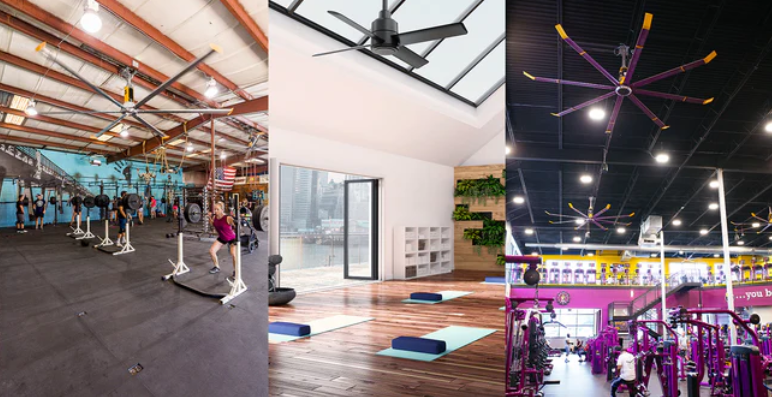
Gym Fans for Powerful Airflow and Workout Comfort
Keeping gym-goers comfortable isn’t just about temperature—it’s about performance, safety, and satisfaction. Running a boutique fitness studio or managing a large commercial facility? The right fan system enhances comfort, improves airflow, and keeps energy costs in check.
Let’s break down why airflow matters and how to choose the best gym fan for your space.
Why Airflow Matters in Fitness Spaces
When the workout heats up, your air circulation needs to keep up. Poor ventilation can lead to excessive humidity, lingering odors, and overheated workout zones—all of which can hurt member satisfaction and performance. With proper airflow, however, you can create a more comfortable environment that supports endurance and reduces fatigue, keeps humidity and odors under control, and improves overall air quality.
Plus, efficient air circulation helps reduce the burden on your HVAC system, lowering energy costs while enhancing temperature consistency throughout the facility.
Key Benefits of High-Performance Gym Fans
-
Temperature Regulation - Fans distribute air evenly to prevent hot spots and help maintain a steady, comfortable workout environment.
-
Humidity and Odor Control - High-output airflow helps remove moisture and stale air, keeping spaces fresh even during peak hours.
-
Energy Efficiency - Fans enhance HVAC performance, meaning your system doesn't need to work as hard to maintain temperature.
-
Member Satisfaction - A well-ventilated gym feels cleaner, cooler, and more inviting, improving retention and reviews.
4 Types of Gym Fans to Consider
Choosing the right type of fan for your gym depends on your space, layout, and airflow needs—here are the most effective options to consider.
1. Ceiling Fans for Gyms

High-volume, low-speed (HVLS) ceiling fans are a game-changer for large fitness facilities. These fans are engineered to move massive volumes of air across wide areas with minimal energy use.
In cardio zones, weight rooms, or full-sized basketball courts, HVLS fans help regulate temperature, reduce humidity, and create a comfortable environment where athletes can perform at their best. Their quiet operation ensures minimal disruption, even during high-intensity workouts or group classes.
Plus, they can complement HVAC systems by preventing air stratification, which helps maintain consistent temperatures from floor to ceiling.
2. Wall-Mounted and Directional Fans

For tighter spaces like yoga studios, spin rooms, or HIIT training zones, wall-mounted and directional fans offer customizable airflow without taking up floor space.
These fans can be tilted or pivoted to target specific areas—ideal for placing airflow exactly where people are training hardest. In group fitness classes where movement is synchronized and sweat is guaranteed, directional fans help keep air fresh and participants cool. They’re also a smart solution for corridors, stretching areas, or transitional spaces within the gym.
3. Pedestal and Drum Fans

Pedestal and drum fans bring mobility and power together in a compact footprint. Designed to deliver high CFM, they’re ideal for garage gyms, personal training stations, or any area where fixed airflow solutions aren’t practical. Their portability allows gym staff or individual users to move them wherever needed, making them a versatile option for changing room layouts or pop-up training areas.
Drum fans, in particular, are well-suited for rugged use and high-output cooling, perfect for CrossFit boxes, warehouse gyms, or boot camp environments.
What to Look for in a Gym Fan
Choosing the best gym fan isn’t one-size-fits-all. Here are the top considerations:
-
Space Size: Match the fan’s output (CFM) to your square footage and ceiling height.
-
Noise Level: Quiet fans ensure a distraction-free experience in yoga rooms or group classes.
-
Mounting Options: Consider ceiling height, wall space, and flexibility for reconfiguration.
-
Energy Efficiency: Look for energy-saving motors and smart controls.
-
Durability: Commercial-grade construction stands up to sweat, dust, and high usage.
Matching Fans to Different Fitness Zones
-
Cardio Zones & Weight Rooms: HVLS ceiling fans deliver wide coverage and efficiency.
-
Yoga & Spin Studios: Whisper-quiet wall-mounted or directional fans maintain calm and comfort.
-
Locker Rooms & Showers: Exhaust fans keep humidity and odors in check.
-
Small or Flexible Spaces: Pedestal and drum fans offer adjustable cooling wherever it’s needed.
Why Choose TBC Supply for Your Gym Fan Needs

We carry the industry's top brands, including Big Ass Fans and Hunter Industrial, and deliver expert support with every order. Building from the ground up or updating an existing space, we’ll help you choose the fan that fits your layout, performance goals, and budget.
Comfort That Works as Hard as You Do
Don’t let stale air and hot zones drag down your gym experience. Shop TBC Supply for the best gym fans to improve airflow, boost comfort, and elevate your facility’s performance.
